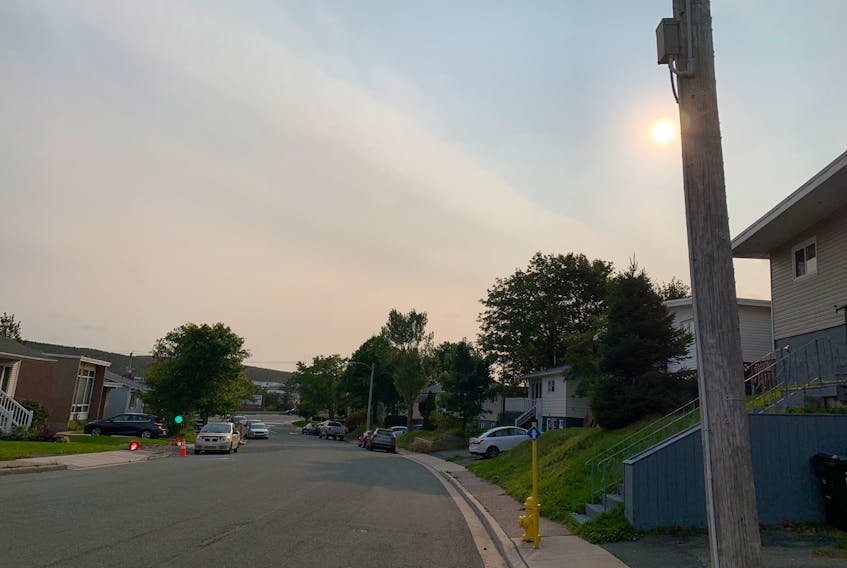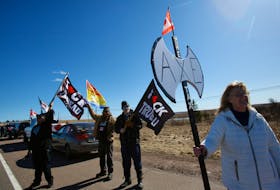It is an average day.
Everyone has finally wheeled their garbage bins back in from the curb. The on-again, off-again home renovation behind me is having a nail-gun day, as opposed to an earthmoving day.
The trio of older men who walk the street have made their daily appearance, barrel-chested and warm-vested, their baseball caps screwed down hard against the wind, their staunch calves sticking out of sensible shorts that easily reach past their knees. I would love to hear what it is they are always discussing so sternly, their faces disappointed like project managers looking over a hopelessly bad concrete pour.
A lone woman walks an arc of dogs, two of them large, one small, all of them spread out apart from each other almost as much as they can be on their leashes ahead of her. Two big black and brown setters lope, while a small terrier eggbeaters its legs to keep pace.
Three young teen boys caterwaul up the street on their way back to high school, each one wearing a backpack, each one clutching a long can of Red Bull energy drink. The hand-crushed cans will end up being tossed virtually simultaneously within a hand’s breadth of the corner community mailbox, a feat of synchronized littering.
It’s a staggering thought, really, that there could be so much smoke that it could still be cohesive after travelling so far — a smoke plume a whole continent wide.
Above them, above me, the sun struggles through swathes of cloud and high forest fire smoke, casting a strangely sick yellowish light when it does break through. I’ve seen the pattern the smoke was expected to take on satellite imagery, watched the denser bands being pulled across the country on the jet stream and then cycling into the spinning vortex of the remains of what was tropical storm Paulette.
It’s a staggering thought, really, that there could be so much smoke that it could still be cohesive after travelling so far — a smoke plume a whole continent wide. The New York Times wrote a detailed story about one of the west coast fires on Thursday, about a fire that burned Detroit, Oregon to the ground, its smoke joining all the rest as it melded its way into the current cross-continental plume.
Detroit, Ore., is 7,341.3 kilometres away from St. John’s, a drive that Google says would take a solid 76 continuous hours, using Interstate I-80 West. (I don’t think they’ve got that right, because no one seems to calculate the time it takes to cross the Gulf of St. Lawrence by ferry — but they do warn about it. “This route includes a ferry — this route has tolls — this route crosses a country border — your destination is in a different time zone.”)
In California, on CalFire’s wildland fire website, if you counted only the active fires that have consumed more than 100,000 acres, you’d get six fires that have burned, so far, 2.2 million acres. Count all the major fires, and it’s 3.3 million acres. And that doesn’t include Oregon, which is also burning; another million acres there. (For scale, the entire province of Prince Edward Island is 1.4 million acres.)
It’s absolutely staggering to think about — and it’s the scalar difference that is so significant. The largest forest fire in Oregon in the 20th century — the Tillamook Burn — incinerated 261,000 acres over 10 days in 1933. This year, Oregon saw 900,000 acres burn in 72 hours. History makes things even more alarming. A megafire is one that burns 100,000 acres or more. For all of the 20th century, there were six in Oregon. So far, in the first two decades of the 21st century there have been 11. Already this year? Five.
You can look the other way and say that nothing is changing. That the weather isn’t drier or more windy, that the hottest temperatures ever recorded in the western U.S. that occurred this summer are all just natural fluctuations.
And, as the U.S. National Hurricane Service runs out of names for new storms this year, hurricane Sally churned slowly up through the Florida Panhandle and inland, dropping as much as 36 inches of rain as it went. Individual weather events, wet or dry, aren’t necessarily a sign of climate change, but they sure are a symptom. All sorts of records are being toppled, and none of it is good news.
You can look out at the street and watch the neighbours mow their lawns in the sickly jaundiced light of something happening a whole continent away and delude yourself that it’s just a passing thing.
It is a new average day.
Russell Wangersky’s column appears in SaltWire newspapers and websites across Atlantic Canada. He can be reached at [email protected] — Twitter: @wangersky.









